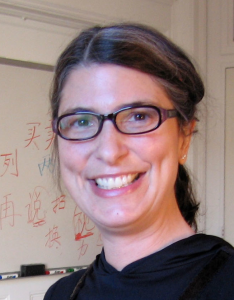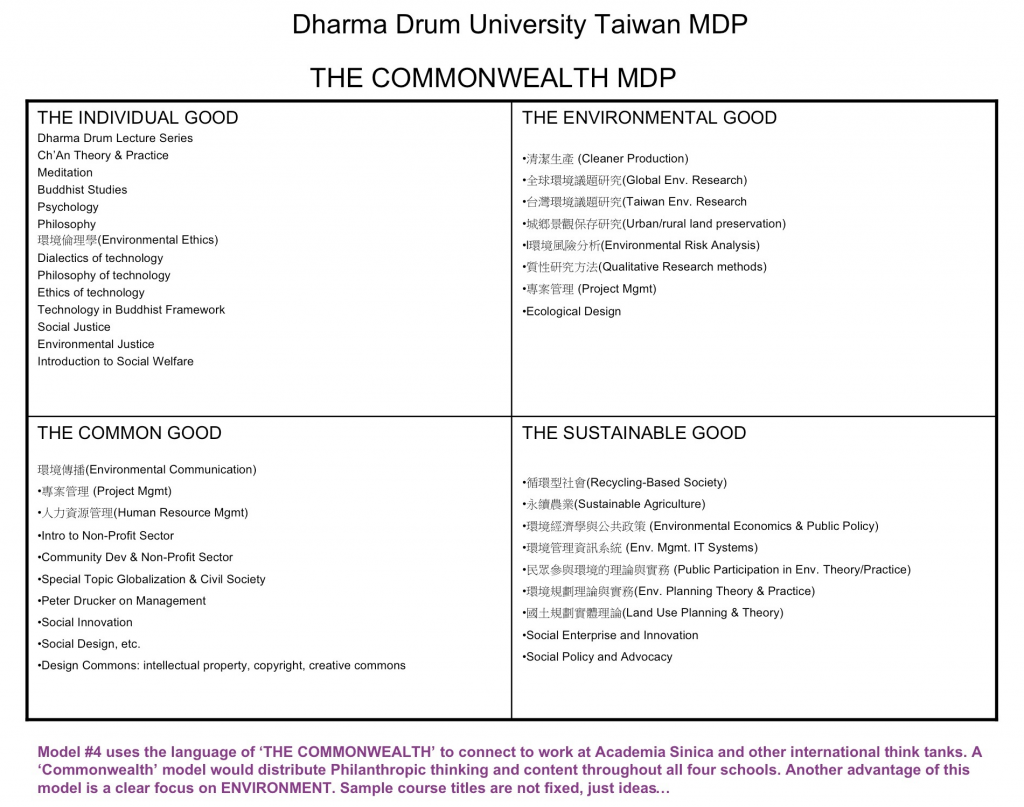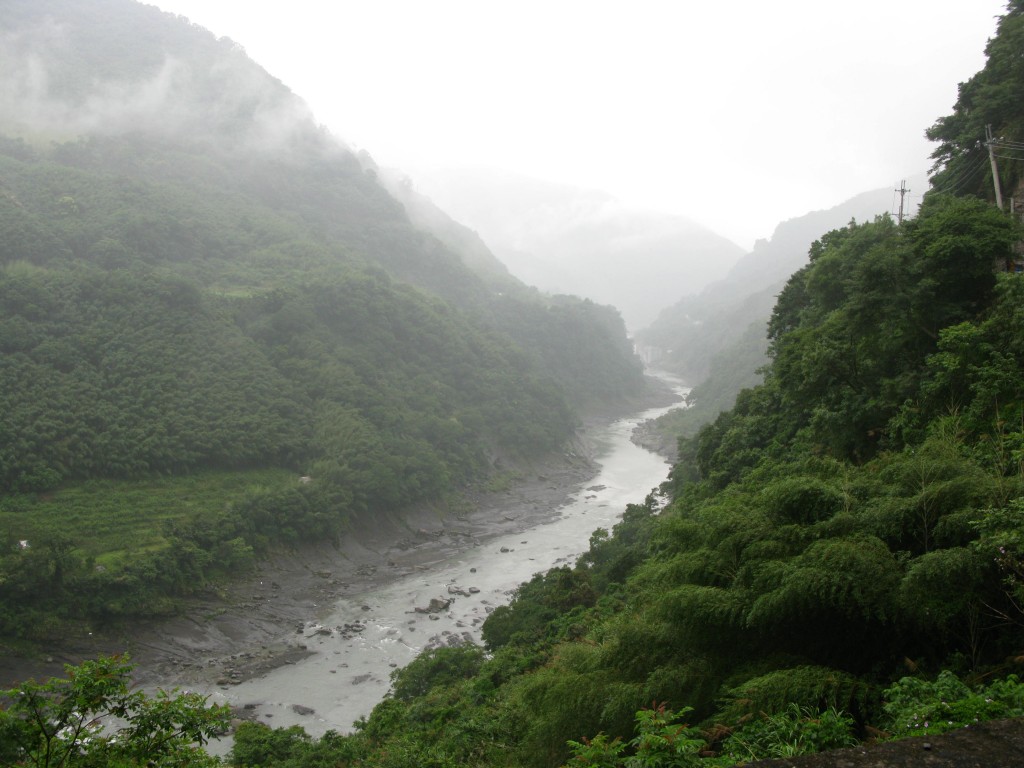Lisa Norton
Face it, Accept it, Deal with it, Let go of it.
Venerable Master Sheng-yen
Our pervasive designed worlds have powerful impacts on our consciousness, attitudes and lifestyles, and vice versa. Living and working in Asia over the last decade, has given me an experiential grasp of cultural dispositions that disclose the built world as created-destroyed, fluid-structuring, given-potentiated, intended-unintended through daily life practices.
In 2008 through the introduction of my American friend in the NGO world in Taiwan, I was invited to serve as an academic consultant to the Preparatory Office of Ch’An Buddhist monastery Dharma Drum Mountain, in Taipei, Taiwan in their effort to develop and launch a graduate school dedicated to cultivating citizen leadership for the future of Taiwan and the world. I was inspired by the radical commitment of President Liu An Chi, his own career a study in servant leadership. Dr. Liu recruited a committed team representative of national and international schools to give form to the late Master Sheng Yen’s vision. In addition to teaching in the soft launch, my role as International Advisor over the next several years included facilitation of curriculum development and interdisciplinary integration between the four colleges: Caring and Practice; Culture and Community; Social Entrepreneurship and Environmental Action.
Taiwan Island, having been spared the regressive trauma of the Cultural Revolution and the Great Leap Forward, yet having undergone numerous waves of Colonial rule, provides a counterfactual diaspora to Mainland China (Shipper), retaining hints of Dynastic China. Colonized by the Dutch, Spanish, Portuguese and Japanese, the cultural demographic is a rich and complex hybrid. Liberal Democratic Republic Taiwan R.O.C. retains elements of traditional Chinese culture, Japanese culture, European Colonial influences, Traditional Confucian ideals, Shinto and Taoist Tribalistic beliefs, along with at least thirteen First Nations Tribes, blueORANGE (Beck) Modern, GREEN Post-modern and increasingly, Second Tier vMEMES. Reappraisal of the Colonial past is strong theme in contemporary Asia particularly so in Post-modern GREEN views of events.
The Japanese ruled Taiwan for 53 years, setting the pattern for Taiwan’s tangible and intangible infrastructural logics in transportation networks, industry and education. When WWII ended the Japanese occupation, Taiwan further rationalized their national economy. Following Japan and Korea, Taiwan upgraded its industrial base to keep pace with the information economy, assuming a position as key IT developer in semiconductors, motherboards, electronic interfaces and now biotechnologies. Confucian scholarly diligence reinforced the standards and examination-orientated society and combined with a strong enterprising and innovative Modern spirit we recognize in the globally competitive Taiwan of today. A Confucian Traditional vMEME governs the ordered organizational and educational culture, blended with an ORANGEgreen business culture adaptive to global best practices. Taiwan is very Internet wired. From electronics and light assembly to microprocessors, Taiwan has established itself as one of the four Asian Tiger economies and now enjoys one of the highest levels of affluence in the world economy. Closely aligned politically with the United States, Taiwan exhibits the promise of Modernity and the hope that progress moves in a unilinear direction.
According to Wikipedia, Over 93% of Taiwanese are adherents of a combination of Buddhism, Confucianism, and Taoism. And cross thirteen aboriginal tribes “…over 64 percent identify as Christian.”(Wikipedia) Since the Taiwan localization movement of the 1990s, Taiwanese cultural identity issues have been prominent in the media. The Confucian doctrine, The Great Learning, remains an inscriptive priority code maintaining conformity throughout the Chinese diaspora. Confucianism co-exists in Taiwan as a secular moral code of interpersonal behavior complementary with polytheistic blends of Taoism, Buddhism and even Christianity.
Although progress and order are evident in the built environment, incoherences with life conditions are subtle yet co-present in the form of ennui and disaffected subaltern populations. As of 2009 this consumer-oriented culture had the second highest suicide rate in the world. Taiwan, also known as Silicon Valley East, is a highly operationalized society, very competitive in sciences and producing a disproportionate number of chemical, mechanical and electronic engineers. But this rational-analytic Expert society was bought at a high opportunity cost in terms of diversity of developmental aptitudes. In the context of educational leadership challenge, this was understood as an adaptability and creativity crisis. To add to the challenge, Taiwan was experiencing a Ph.D. glut. During provisional approvals by the Ministry of Education, Dharma Drum was counseled above all to innovate.
Contrary to most media reports, academic and business competition along with bonds of enterprise and marriage continue apace between Taiwan and Mainland China. Although most of Taiwan’s industrial production is outsourced to China, Taiwan is acutely sensitive to technological evolution in China. Taiwanese business understands that China is quickly closing any manufacturing sophistication gaps that may have existed five years ago. Although China still remains the ‘factory of the world’ aspirational design intelligence along with the shadow side of manufacturing, the ‘race to the bottom’ are big waves breaking over the flat world. This leaves tiny island nation Taiwan leaning toward a sensible strategy- high quality innovation over a long, planetary time horizon.
Dharma Drum Mountain is one of four major Buddhist sects on Taiwan, having established Sanghas all over the world. This Ch’An line developed originally from Mainland China. In 1978, Dharma heir Venerable Master Sheng-yen, a renowned intellectual and environmentalist was named one of the fifty most influential people on Taiwan over the past four hundred years. In 1989, under Master Sheng-yen‘s leadership the institution bought land on Jingshan Mountain in Taipei County in order to expand into education. Master Sheng-yen died in February of 2009 at the age of 80. He specified that his body be cremated, confident that his influence could be leveraged to inscribe more eco-friendly death rituals and perhaps shift public opinion away from formaldehyde and other embalming toxins. Not well known in the West, his collected works are now being published posthumously by Shambhala Press.
The Dharma Drum Mountain monastery vision is to ‘uplift the character of humanity and build a pure land on earth.’ (Sheng-yen) Today Pure Land Buddhism is, together with Ch’An (Zen as it evolved in China), the dominant form of Buddhism in China, Korea, Japan, Taiwan, and Vietnam. Entering the Pure Land is popularly perceived as the attainment of enlightenment. In developing Dharma Drum College, Master Sheng-yen’s vision was translated into a dynamic process of dialogue and practice where ideas transform the self and in turn the greater community. Dharma Drum College was a response to the need for higher education with a rich cultural orientation, spiritual vision and attention to global needs.
Our development of curricula for intra- and inter-college synergies were based on AQAL (mostly quadrant) understanding that no single discipline can sufficiently address complex challenges, yet every discipline holds pieces of the puzzle. Sustainability is the name we currently give to a hypothetical dynamic state that may or may not one day exist. How we interpret its meaning is less important than its bare existence as a super ordinate goal. Our mandate was conceived from the beginning as being about societal thriving from a world-centric perspective.
Ch’An fundamentals provided the platform for the two-year Masters degree program based on the Buddhist values of Compassion, Wisdom, Harmony and Respect. Our key guiding rubric was the Dharma Drum Mountain mission of protecting the spiritual environment.
Xin ling huan bao (心靈環保) is usually translated as psychological well-being, but the literal meaning is ‘soul environmental protection’ or ‘spiritual ecology’. Master Sheng-yen’s desire was to create a university for the world, based in Taiwan and dedicated to creation of Pure Land on Earth through skillful means. Dharma Drum College aimed to cultivate contemplative Zen Buddhist practice, service and outreach.
Our task was to integrate the curricular planning work of the four schools that would comprise the university. We needed a schema to accommodate both linear mind and Buddha Mind, we needed a framework to acknowledge and validate each viewpoint so that our collective vision was not reducible to academic, activist, entrepreneurial, or contemplative spheres. Master Sheng-yen said that Dharma Drum College would have to move beyond competition. And so it was. This work necessitated unprecedented levels of interdisciplinary cooperation. Individuals, firms, and educational institutional institutions offered opportunities to partner on initiatives based on confidence in Master Sheng-yen’s vision and the Dharma Drum public service record.
Our team of eight was headquartered in an eco-efficient and earthquake-proof high rise in downtown Taipei, about an hour’s drive from the splendid ecological community tucked away in the wooded mountains housing the monastery and the active construction site of the future Dharma Drum College. We enjoyed organic vegetarian meals prepared daily by the nuns and of Dharma Drum Mountain.
Our beta curriculum was modest but passion-driven and correlated to local needs. We developed curricula to foster sustainable food and water communities, and kick start the NPO and NGO sectors. Our team prioritized immersion in project-based learning balanced with contemplative practice, reflection and personal growth. The self-design of a life plan of passionate commitment, integration, and skills in alignment with the urgent tasks of the present and future. We used the Integral framework to assess curriculum development across the four colleges and to accommodate multiple modes of social interaction, ways of knowing, and different perspectives. Theory U, Social Presencing Theater, Dialogue, Open Space and World Cafe methods were already in use at the preparatory office along with familiarity and openness to Integral Theory and Spiral Dynamics. We tailored various methods in our efforts to identify collaborative approaches to bringing forth emergent educational structures for the Taiwanese context.
Admission to Dharma Drum College would be through one of four concentrations: Caring and Practice; Culture and Community; Social Entrepreneurship and Environmental Action. In order to ensure the theory-practice integration and trans-disciplinary teamwork experiences we wanted our students to have, the action research platform Case Story served as a hinge between the capacities and contributions of each of the four concentrations and external partners.
In the context of the ‘creativity crisis’, the Dharma Drum curriculum was in some respects hailing the subaltern creative class who do not test well in the mainstream math and science curriculum. Many of these young people tend to be critical, non-linear thinkers who may choose to study abroad or attend one of the many well-established Buddhist monastery schools as alternatives. In reaching out to other populations, our planning process engaged students representative of a stratified spectrum from tribal-centric through planet centric values during our soft launch.
We developed a narrative around climate to serve as the inaugural action research platform shared between our four colleges and external partners. Because typhoons and earthquakes are rather common in the region, the rising sea levels expected to accompany extrene weather scenarios would make resettlement to the mountainous interior the only viable option for many Taiwanese citizens. As a curricular narrative, climate change seemed the ideal rubric within which to publically position the sacred mission of Dharma Drum. Having as it did life and death, finitude, legacy, intergenerational ethics, data analytics and interpretation, politics, incentives and policies, techno-scientific measures, individual and societal values and behaviors, messaging and branding, just for starters.
Despite the promising AQAL tetra-mesh our team arrived at a philosophical quandary. We cannot, in the end, ‘change’ the climate change (Gu) at least not in ways meaningful within an individual lifetime. And even more chilling, in some important respects it may be too late. Somehow the question arose, why act at all on climate change? Or for that matter why act on anything at all? This polarization flattened the subtle paradox revealed in Buddhist thought on non-action, bringing our work to an apparent standstill. Yet before we knew it, we were re-engaged in hopeful explorations of action and non-action. Action or contemplation, which is more valid? Is Non-action the same thing as inaction? What does is mean to change the world? What did it mean for this apparent practice and theory split to be emerging at this moment?
The climate debate, like sustainability, is a fuzzy concept, existing as a multiple object (Sean Esbjörn-Hargens) that engages core values conflicts. In a fractal way they reflect the competing vMEMES and the resultant artifacts of a diverse Taiwan. I regret that I did not see it at the time, but an ethics of Integrity (Kasulis) -a Modern vMEME- demands ecological responsibility and justice. While on the other hand an ethics of Intimacy -a relativistic Post-modern vMEME- demands ecological presence and engagement. Climate thus proved to be too controversial within our planning group and it was put aside in favor of two rich yet less polemical Case Stories. Although too challenging as an educational rubric in 2009, it remains an interesting stretch goal given Life Conditions (Beck) such as island states that may call for it.
In the Chinese language, the word for heart and mind are one in the same. As the ultimate reality, the heart/mind is identified with benevolence and with the original substance common to people, heaven, earth and all things. The importance of true heart/mind vision cannot be overstated. In order to develop the curriculum we had to first design an interim change platform for individual and collective transformation. We had to collectively envision structures of transformation in order to allow the unknown to come into being through us.
We held creative tension while faculty, staff and students were called to the real-time personal transformations necessary for this radical re-think of how education might work. Values conflicts also emerged amongst our team that included Buddhist, Jesuit, First Nations and Han Chinese, as well as public servants and academics. Most helpful was returning to common goals that spoke to the range of values and allowing participants to retain their own reasons and motivations.
Balancing critical inquiry with appreciative inquiry is especially important in orangeGREEN academia. What looks like an either/or to the subject/object-conditioned mind, seen from another vantage point can suddenly transform as a dynamic dialectical space of creative potential. Knowing that my Western bias would have both positive and negative impacts on this process, my approach was to mostly listen and inform myself, also speaking my awareness of my cultural distance as an American in attempting to facilitate the deepening trust necessary to spark collective creativity. My intermediate level Chinese was sorely tested by the level and pace of our spirited work sessions. Through shared adaptations to challenges our learning organization slowly became hardier and more synergistic. To create a true vision, some creative chaos and loss of control must enter into the process. That too requires mutual trust.
What questions are emerging right now? How might our religious or philosophical differences threaten this project? As we make the road by walking (Friere, Horton) we were keenly aware as we were stretched into new levels of interdisciplinary cooperation that our students would have to expand their expectations about how and where learning occurs.
Although most of us had no prior working relationships we shared a passion and a vision and that saw us through the demanding process. What appeared as political or ideological differences among team members, understood through a Spiral Dynamics Integral (Beck) lens revealed deeper vMEMES. In being and becoming a community of dialogue, we identified ways to speak to fears and core values directly while anchoring the team in shared causes.
A shared narrative entitled Beautifulisland@Taiwan served as our inaugural Case Story. Beautifulisland@Taiwan was designed to serve as a programming platform at multiple scales of awareness and engagement during the inaugural years of the Dharma Drum College launch. The action research platform Beautifulisland@Taiwan was a Small is Beautiful (Schumacher) story about relationships and environments in this time of great urgency and change. Beautifulisland@Taiwan embodied both the regenerative future of the eco-commonwealth and the bodhisattva vow.
The curricular story Beautifulisland@Taiwan played host to several action research projects related to Taiwan ecological modernization, the quality economy, time banking, local food and water networks, and industrial ecologies. A fascinating aspect was the branding and marketing of Taiwan local-ness, along with the crafting of compelling narratives of alternate cultural futures. The name Beautifulisland@Taiwan was a play on Lovely Taiwan, the marketing language of a prominent national tourism campaign. It appropriated ‘Formosa’ the Colonial Era term for Taiwan, meaning ‘beautiful island’ in Portuguese, and also leveraged the semantic weight of the word ‘beautiful’ in relation to ‘lovely’ in the Chinese language.
The Beautifulisland@Taiwan is a holon of a second research platform built on an already successful NGO network, the Thousand Mile Trail. (千里步道籌畫中心) In Taipei County at the time, an established NPO project illustrated the timeliness and significance of climate and ecological issues. The Thousand Mile Trail, a participatory public-access project initiated in 2006, is an island-wide trail network connecting citizens with historical, cultural, and ecological richness of place. Going beyond recreation and eco-tourism, the Thousand Mile Trail is a social movement- a broad-based, non-partisan and growing community constituency that seeks to transform society for the good. The Thousand Mile Trail engages community stakeholders at multiple scales and being geo-spatial as well as networked, lends itself to studies of commonwealth, technology access, communication, and alternative transportation infrastructure. Wired Taiwan is a good candidate for early adopter of community building technologies and we sought to develop an ethics of human-technological relations such as PPGIS (public participation geographic information systems).
With these inaugural Case Stories as a container, our courses were driven by civic concerns on Taiwan and intended to seed the growing hybrid enterprise sector. We eventually developed nearly 40 scenarios for sustainable Taiwan futures, sensing ways to weave back into curricula. Dozens of opportunities emerged thanks to the eager participation of would-be graduate students and citizen volunteers from the Dharma Drum Mountain community and the greater Taipei County area.
My dear colleague Leemen Lee, of the College of Social Entrepreneurship and Philanthropy, conceived of an ambitious global Phase II action research platform focused on Equity and Social Capability and aiming for two-three years after the program establishment. The plan was to reconsider the dialectical challenges of poverty and environmental crisis in an attempt to move beyond the global best-practices mindset of sustainable development.
The Equity and Social Capability Development Action Research platform would require students and faculty of Dharma Drum College to look at old problems from a new level of consciousness. Social innovation project partnerships were planned in India and a large-scale restorative organic agricultural pilot was planned in conjunction with Sichuan Agricultural University in Mainland China. This platform would augment Dharma Drum Mountain Monastery’s ongoing international relief network. Dharma Drum Mountain serves earthquake and tsunami relief efforts throughout Asia, extending the values of this culture beyond the immediate sub-group to all humanity, all life, enacting a responsive ethics of compassion and social action.
Taiwan is recognized for craft logic within a conservative as opposed to a disruptive culture. Although Taiwan’s strengths tend to be quantitative and computational, our program called for co-valuing of metrics. All approaches are needed-the quants and the quals working together in a collaborative knowledge ecology. This is a tall order but achievable when the artifacts of society are understood as fluid and structuring, as demonstrated in Taiwan over the last one hundred years. Social Innovation is really hot amongst social activists and change agents seeking to humanize Taiwan’s sophisticated technological infrastructures. We sourced innovations in the Nordic countries, Sweden in particular, for models in social design and entrepreneurship. The twelfth most densely populated country in the world, Taiwan, due to its small land mass, high density, and engineering efficiency, has one of the tightest post-consumer waste handling systems in the world- a key industrial ecology intelligence for export to the world. Retrofitting of infrastructures and metrofitting (Fry) of city infrastructures was part of a larger project we conceived as broadening the practice of engineers and materials scientists. Non-violent package design would seek biodegradable alternatives to the problem dubbed ‘monstrous hybrids’ (McDunough) -composite materials that cannot be safely recycled in either the technical or the organic ecologies.
Taiwan has an abundance of 24-hour convenience stores such as 7-11 and local rival Family Mart, which in addition to the usual defuturing stuff, provide services on behalf of financial institutions or government agencies such as collection of parking fees, utility bills, traffic violation fines, credit card payments, even package delivery. The 7-11 model, delivering Modern convenience and speed at a premium, is wildly successful in this heavily blueORANGE society, as evidenced by the presence of convenience stores at virtually every corner. Our team had identified 7-11 as an ideal sustainability awareness partner, its distribution well situated to deploy alternative quality lifestyle choices and information for consumers and, we had hoped, having a shared interest in lower-material-impact futures.
With a literacy rate of 96.1 percent and ranking among the highest test scores in the world, educators in the R.O.C. are among the best. Yet the fact remains that existing structures will never produce alternative futures. We realized that our planning process actually had a meta-agenda-to change the benchmarks for education in Taiwan. From an organizational perspective, building a new kind of Masters program required that we take care (momentarily, hourly, daily) not to reproduce educational norms such as unidirectional and passive learning stances. Looking ahead our team saw that existing assessment standards would not serve, and any new standards, to be genuinely useful, would have to be tailored to whole individuals, with multiple intelligences and multiple worldviews, while also accounting for a wide variety of contextual factors. Over several reviews by the Ministry of Education, it seemed there were no comparables at least in Taiwan higher education. We again dared to think outside the black box. The most disruptive innovation of the Dharma Drum College Preparatory Office was our challenge to accreditation and assessment.
Affluent and educated Taiwan had stretched to ask, how might we produce whole individuals (rather than experts) in service to the needs of the future? This expansive aspiration acted as a strange attractor that led to reframes of our big assumptions. Regrettably, the Dharma Drum preparatory initiative was not advanced, a painful disappointment for the entire team. Although unrealized, the experience gifted me with powerful creative lessons and significant friendships. This dynamic process demonstrates the kind of visionary initiatives emerging in developed and affluent societies that can afford the luxury of truly long-range visions.
WORKS CITED
Beck, Don Edward and Cowan, Christopher. Spiral Dynamics: Mastering Values, Leadership and Change. Oxford: Blackwell. 1996
Bohm, David. On Dialogue. London: Routledge. 2004
Esbjörn-Hargens, Sean. “An Ontology of Climate Change: Integral Pluralism and the Enactment of Multiple Objects” Journal of Integral Theory and Practice, 5(1), pp.143- 174.
Fry, Tony (Ed.) “The Plural Nature of the Urmadic City”. The Urmadic City: The idea and the Image. Brisbane: Queensland College of Art. 2011.
Friere, Paolo and Horton, Miles. We Make the Road by Walking. Philadelphia: Temple University Press. 1990.
Gu, Aries. Personal communication, July, 2009.
Hayashi, Arawana. Social Presencing Theater.http://www.arawanahayashi.com/socialtheater.htm
Kasulis, Thomas. Intimacy or Integrity: Philosophy and Cultural Difference. Hololulu: University of Hawai’i Press. 2002.
Open Space. Web. http://www.openspaceworld.org/
Sheng-yen, Chan Master. Shattering the Great Doubt: The Chan Practice of Huatou. Boston: Shambhala. 2009.
—. 108 Adages of Wisdom. Taipei: Sheng-yen Educational Foundation. 2008
—. The Six Ethics of the Mind Campaign. Taipei: Dharma Drum Mountain. Web. http://www.dharmadrum.org/content/about/about.aspx?sn=113
Scharmer, Otto. Theory U: Leading from the Future as it Emerges. San Francisco: Publisher: Berrett-Koehler Publishers. 2009.
Schipper, Kristofer. The Taoist Body. University of California Press. 1994.
Schumacher, E.F.. Small is Beautiful: Economics as if People Mattered. New York: Harper Perennial. 1989.
Thousand Mile Trail. Web. http://www.tmitrail.org.tw/
Wikipedia. Web. http://en.wikipedia.org/wiki/Taiwan
Wilber, Ken. A Theory of Everything: An Integral Vision for Business, Politics, Science and Spirituality. Boston: Shambhala. 2001.
World Café, The. http://www.theworldcafecommunity.org/
About the Author
Lisa Norton, Professor, the School of the Art Institute of Chicago, Department of Architecture, Interior Architecture and Designed Objects. Professionally she consults with educational organizations on development and change in the design educational and professional contexts. lisanorton@mac.com




